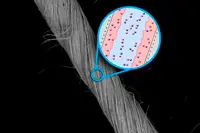 Researchers at MIT and the University of British Columbia claim to have found a promising new approach to delivering the short, but intense, bursts of power needed by wearable electronic devices. The trick, they say, is to use yarns made from niobium nanowires 140nm in diameter as the electrodes in tiny supercapacitors – pairs of nanowires with an insulator between them.
Researchers at MIT and the University of British Columbia claim to have found a promising new approach to delivering the short, but intense, bursts of power needed by wearable electronic devices. The trick, they say, is to use yarns made from niobium nanowires 140nm in diameter as the electrodes in tiny supercapacitors – pairs of nanowires with an insulator between them.
"Imagine you've got some kind of wearable health monitoring system," says Professor Ian Hunter from MIT, "and it needs to broadcast data, for example using Wi-Fi, over a long distance." At the moment, the coin sized batteries used in many small electronic devices have very limited ability to deliver a lot of power at once, which is what such data transmissions need.
"Long distance Wi-Fi requires a fair amount of power," says Prof Hunter, "but it may not be needed for very long. We know it's a problem experienced by a number of companies in the health monitoring or exercise monitoring space. So an alternative is to go to a combination of a battery and a capacitor." A battery caters for long term, low power functions, while the capacitor provides short bursts of high power. Such a combination should be able to either increase the range of the device or reduce its size.
Ideally, Prof Hunter says, it is desirable to have high volumetric power density and high volumetric energy density. "Nobody's figured out how to do that," he says. However, he adds that, with the new approach: "We have fairly high volumetric power density, medium energy density and low cost."
Niobium is abundant and widely used, so the team believes the whole system should be inexpensive and easy to produce. Other groups have made similar supercapacitors using carbon nanotubes or other materials, but the MIT team believes niobium yarns are not only stronger, but also 100 times more conductive, allowing niobium based supercapacitors to store up to five times as much power in a given volume as carbon nanotube versions.
Although the material has been only been produced in the lab, the team is now working on how to design a practical, easily manufactured version.
Author
Graham Pitcher
Source: www.newelectronics.co.uk

